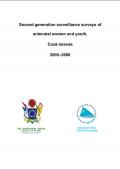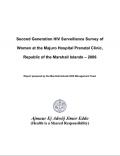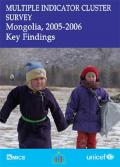What's New
Displaying results 4441 - 4450 of 4914

Resource | Publications,
Many countries in Asia are experiencing epidemics of human immunodeficiency virus (HIV) in injecting drug users and female sex workers. These epidemics are characterized by a marked contrast in patterns of HIV transmission both within and between countries. The situation in the neighbouring countries of Cambodia, the Lao People’s Democratic Republic and Viet Nam provides a part ticular illustration of sharply contrasting epidemic patterns.
As part of the intervention project Community Action for Preventing HIV/AIDS in Cambodia, Viet Nam and the Lao People’s Democratic Republic, baseline surveys were conducted in 2002 to provide a basis for short- and long-term evaluation.
This report aims to study patterns and determinants of HIV prevalence and risk-behaviour characteristics in different population groups in four border provinces of Viet Nam.

Resource | Fact Sheets,
The population of Democratic People's Republic of Korea is estimated at 22.7 million with a growth rate of 0.54%. More than 60% of the total population is urban. The total fertility rate which was above the replacement level of fertility in 1990 had reduced to 2.0 in 1999. The crude birth rate of the country is 16.7 and crude death rate 9.9. DPR Korea has 100% literacy rate for both men and women.
Maternal mortality ratio has increased from 54 maternal deaths per 100,000 live births in 1993 to 105 in 20002 and infant mortality rate from 14.1 per thousand live births in 1996 to 21.8 in 2002.

Resource | Publications,
The Child in Need Institute (CINI) operated an HIV/AIDS Voluntary Confidential Counseling and Testing (VCCT) center and a Reproductive Health (RH) clinic at separate locations. Concerns about lack of service coordination as well as cost and revenue considerations led CINI to integrate the two services. CINI conducted an operations research (OR) study to examine the impact of integration on utilization and revenues.
The objective of this study was to examine whether integration of services would yield an increase in clients served and improve the financial position of the program. A monitoring system was established to capture utilization, cost, and revenue data. The utilization analysis focused on determining if more clients received services, and measuring the proportion of clients who received both RH and VCCT services. The financial analysis focused on determining whether the provision of services to a client (separately or together) added more to program costs or to program revenues.

Resource | Publications,
In 2005 and 2006 the Cook Islands Ministry of Health, with technical assistance from the Secretariat of the Pacific Community, conducted second generation surveillance (SGS) surveys of antenatal women and youth. This report summarizes the results of the SGS surveys in the two population groups.
Surveys were administered to a total of 100 antenatal women between May 2005 and June 2006, and 94 surveys were eligible for final reporting.

Resource | Presentations,
The objectives of the Integrated Biological and Behavioral Survey (IBBS) are:
- Measure estimates of the following among IDU, FSW, and MSM populations.
- Provide key information for advocacy and policy making including UNGASS indicators
- Use information for national estimates and projections.

Resource | Publications,
There is limited understanding of knowledge and behaviors related to HIV and other sexually transmitted diseases (STD) in the Republic of the Marshall Islands (RMI). The RMI Ministry of Health, in collaboration with the Secretariat of the Pacific Community and with technical assistance from the U.S. Centers for Disease Control and Prevention, conducted a Second Generation HIV Surveillance (SGS) survey. This report summarizes the results of the SGS survey of pregnant women at the Majuro Hospital Antenatal Clinic.

Resource | Publications,
In 2003, a regional proposal to strengthen HIV surveillance and related laboratory capacity in six sentinel Pacific Island Countries and Territories (PICTs) - Fiji, Kiribati, Samoa, Solomon Islands, Tonga, and Vanuatu - was funded by the Global Fund to Fight AIDS, Tuberculosis, and Malaria (GFATM). The implementation of Second Generation HIV Surveillance (SGS) will develop and enhance existing sexually transmitted infection (STI), HIV and behavioural surveillance systems and provide epidemiological data on which to design and evaluate targeted interventions.

Resource | Publications,
The 2005 Cambodia Demographic and Health Survey (CDHS) is a nationally representative sample of 16,823 women and 6,731 men age 15-49. The 2005 CDHS is the second comprehensive survey conducted in Cambodia as part of the worldwide Demographic and Health Surveys (DHS) projects. The primary purpose of the CDHS is to provide the policymakers and planners with updated and reliable data on fertility, family planning, infant, child and maternal mortality, maternal and child health, nutrition, malaria, knowledge of HIV/AIDS, prevalence of HIV, women’s status and domestic violence. The 2005 CDHS is the first survey in Cambodia to provide population-based prevalence estimates for HIV.

Resource | Publications,
The Thailand Multiple Indicator Cluster Survey (MICS) December 2005 – February 2006 was developed, for the first time, to collect data on situations of all children in Thailand to be used as tools in monitoring and evaluation of child development in Thailand. As also indicated in the Thailand Millennium Development Goals Report (2004).

Resource | Publications,
MICS Mongolia was designed to provide statistically sound and internationally comparable data for monitoring the situation of women and children in Mongolia. Among the social indicators used in the MICS Mongolia are those required for monitoring the goals and targets of the Millennium Declaration, the World Fit for Children Declaration and Plan of Action and the goals of the United Nations General Assembly Special Session on HIV/AIDS. Mongolia conducted the first and the second rounds of MICS in 1996 and 2000.





